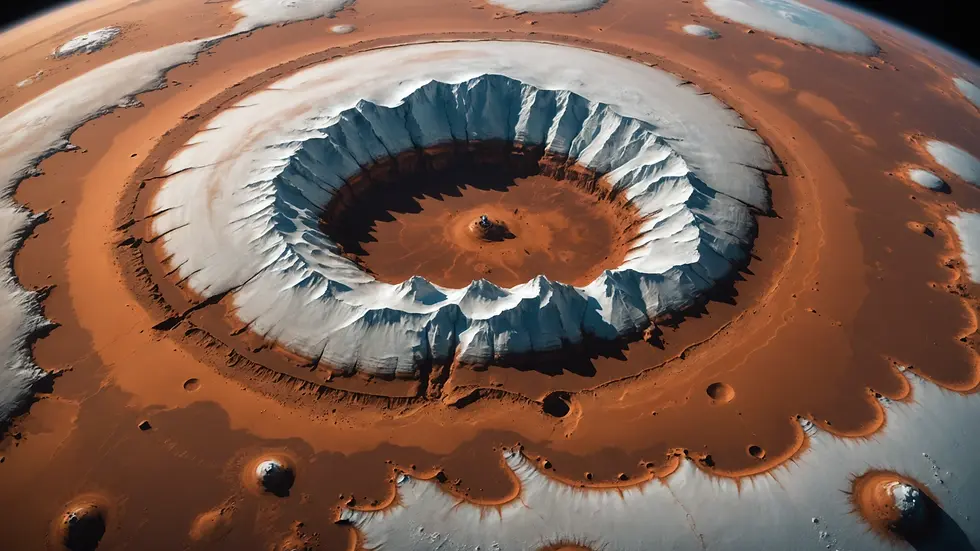The Science of Terraforming: Can We Engineer a New Earth?
- April C.

- Mar 6
- 4 min read
The idea of terraforming has intrigued people for decades. It combines our fascination with space and the desire to make other planets similar to Earth. This is not just a question for science fiction; with the growing challenges like climate change and limited resources on our planet, we find ourselves asking: Can we create a new Earth in the cosmos?
What is Terraforming?
Terraforming is the theoretical idea of changing an unwelcoming environment into one that can support life. This transformation often involves altering a planet's atmosphere, temperature, and surface conditions. While Mars is the leading candidate for this process, moons like Europa and other celestial bodies are also being considered.
Terraforming does not merely aim to make a planet habitable; it opens up crucial scientific, ethical, and logistical discussions. Key questions include: What technologies do we need? How long will the transformation take? What unexpected consequences could arise from such significant changes?
The Science Behind Terraforming
Mars: The Most Viable Candidate
Mars stands out in discussions about terraforming due to its similarities with Earth, such as a day length similar to ours and the existence of polar ice caps. Scientists believe we can alter Mars’ environment to make it more hospitable for human life.
The first essential step in terraforming Mars would be warming the planet, which currently has an average temperature of about -80 degrees Fahrenheit. One proposed method to achieve this involves releasing greenhouse gases into the atmosphere, which could trap solar heat. A study estimates that producing and releasing around 2 billion tons of CO2 could sufficiently raise the atmospheric pressure and temperature, making Mars more livable.

Building an Atmosphere
After warming Mars, the next step would be establishing a breathable atmosphere. Currently, Mars has a very thin atmosphere made up mostly of carbon dioxide, with less than 0.2% oxygen.
To tackle this, one solution involves bioengineering projects, where specially designed plants could be introduced to produce oxygen. A single small tree can generate enough oxygen for two people annually. Thus, requiring vast quantities of these engineered plants would be a long-term yet essential undertaking.
Another avenue is to create machines that can replicate photosynthesis, even under challenging Martian conditions, freeing oxygen and contributing to a thicker atmosphere.
Water Management
Water is vital for life, and terraforming Mars would require reliable water sources. While water ice is found at the poles and below the surface, turning it into accessible liquid water is essential for supporting life.
One idea includes using solar mirrors to focus sunlight on the polar ice caps, which could help melt the ice and release water vapor into the atmosphere. Research indicates that this method could increase atmospheric pressure and ultimately lead to the formation of liquid water bodies—key to promoting life on the planet.

Challenges of Terraforming
While the idea of terraforming is exciting, it comes with numerous challenges.
Time Frame
One of the biggest hurdles is the timeline for successful terraforming, which could take hundreds or even thousands of years. This raises concerns about human investment in such long-term endeavors, as patience often wears thin.
Ethical Implications
The ethics of terraforming raises many questions. Should we intervene in the natural course of another planet? Also, introducing Earth-based organisms could have unintended effects, such as the elimination of any existing Martian life forms, which we may not even know about yet.
Technological Limitations
Current technology is far from ready to handle the complexities of terraforming. We would need breakthroughs in genetic engineering, robotics, and large-scale industrial processes. For instance, climate engineering technologies must be developed first to enable the successful transformation of a hostile planet like Mars.
The Future of Terraforming
As we gain more knowledge about the universe, discussions around terraforming evolve. Some scientists suggest that blending existing technologies with breakthroughs in areas like artificial intelligence and biotechnology could lead us to feasible solutions.
New Frontiers
Exploring moons such as Europa, where there are underlying oceans beneath icy shells, may inspire innovative terraforming techniques that focus on creating new and sustainable ecosystems rather than merely replicating Earth's conditions.
Additionally, advancements in space travel might soon allow us to establish colonies on Mars, providing us with our first taste of life in an extraterrestrial setting. The insights we gain from this experience could greatly influence future terraforming efforts.
Imagining a New Earth
The potential of terraforming presents a captivating mix of challenges and opportunities. Although transforming another planet to resemble Earth may seem far-fetched, ongoing research and technological advancements continue to spark interest.
As we work to address crucial environmental issues on our planet, the concept of terraforming challenges us to reflect on how we interact with nature and our responsibilities as caretakers of Earth. Terraforming becomes not just a quest to create another Earth, but a call to better respect and preserve our own.
As we gaze at the stars, the aspirations of humanity will undoubtedly drive our exploration and understanding of life beyond our planet. The journey of terraforming may continue to enrich our curiosity and provoke our innovation in meaningful ways.
By: April Carson
---
Embracing Authenticity: The Journey of Self-Discovery and Empowerment w/Elisabeth Carson.
Ready to elevate your consciousness and expand your mind?









Comments